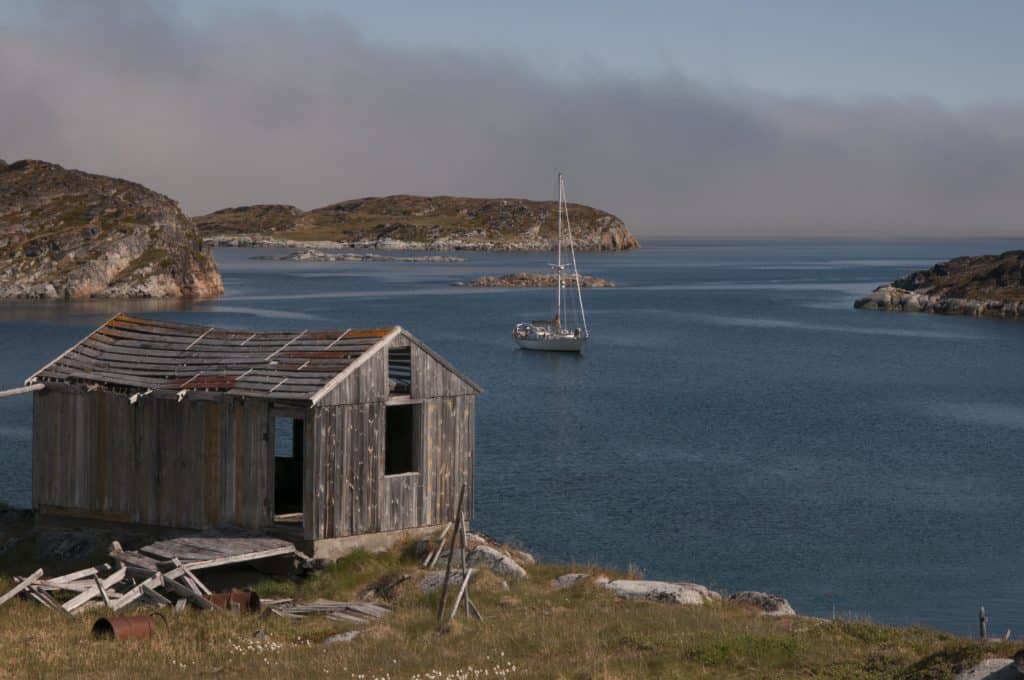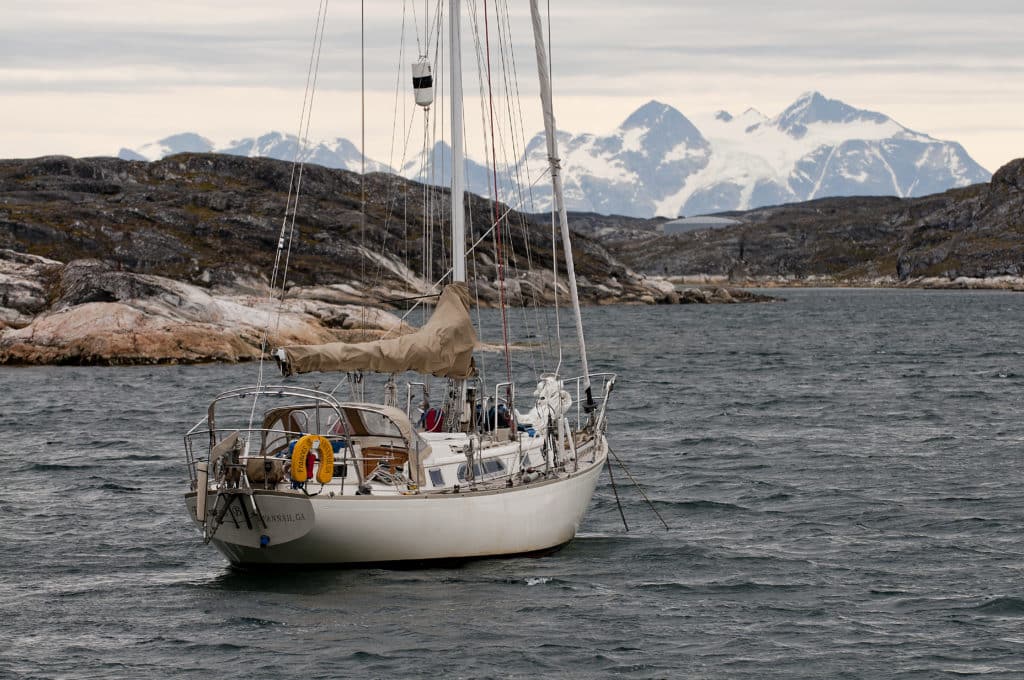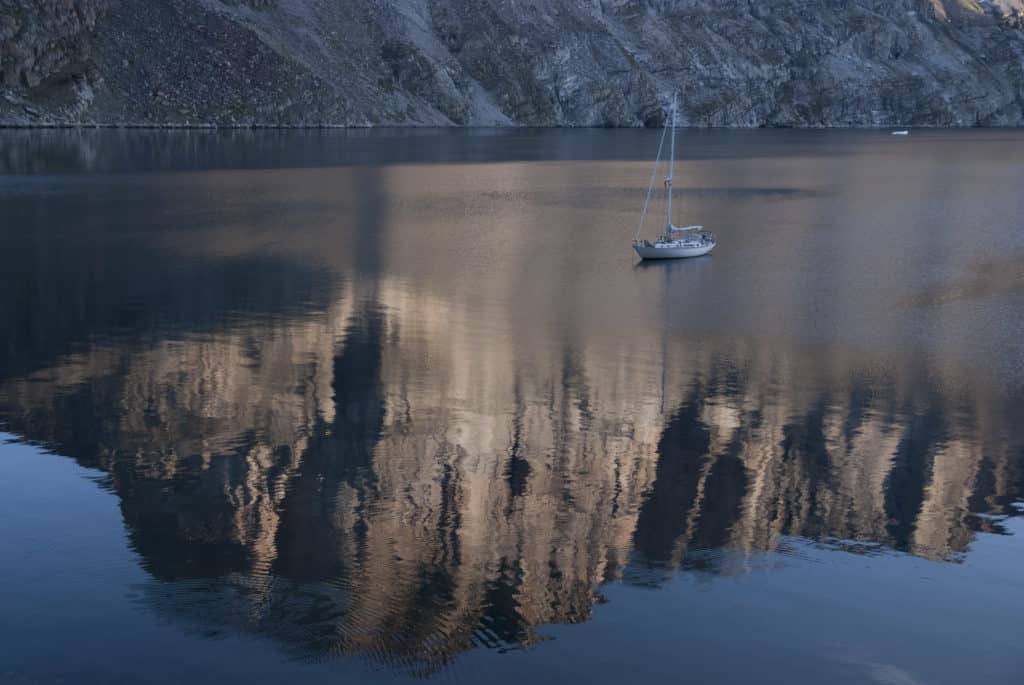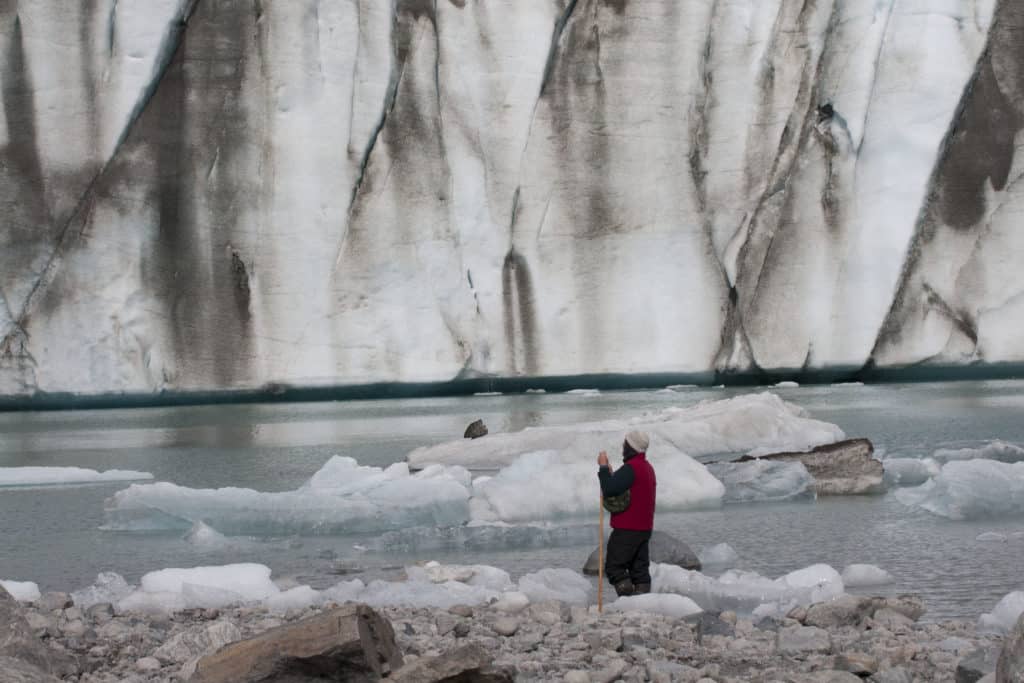
We turned downwind, and as my eyes quit watering in the cold blasts, I could steer straight for a narrow, open slot in the rocky shore. Inside, the water was wider as I turned the boat into a squall and had to rev up the motor to keep moving. Suddenly my wife, Nancy, and our friend Trish, who were on the bow, began waving their arms and yelling, “Rock, rock!” With the engine now screaming in reverse, the bow rammed it while the wind punched us on the beam, and good old Frances B, our Mason 44, heeled over and slid off.
We had just reached Færingehavn on the west coast of Greenland. We anchored in a spot that we had found was free of bottom weeds during our cruise there the year before, then we slipped below to warm up over mugs of tea. Night came, in name only, since at 63 degrees, 40 minutes north on the Fourth of July, the light stayed on. A gale whistled in the rigging and moaned over the surrounding hills. We thought of Evans Starzinger, at sea now on his 47-foot Hawk. He left Hawke Harbour, Labrador, three days after us, but he was sailing fast across Davis Strait and catching up quickly. During the nearly six-day passage, scattered ice had forced us to slow down and even heave-to once. The radar would not detect low growlers, and in those lower latitudes, the nights, though short, were dark. Evans, singlehanding, would have to get some sleep now and then. But at 0600, I stuck my head out and, amazingly, there was Hawk at anchor.
Færingehavn, once a busy fishing harbor, lies about 30 nautical miles from Nuuk, a small modern city and the capital of Greenland, where almost a third of the country’s 56,000 citizens live. Judging by our experience from two previous visits, we knew that lousy weather tends to linger in the fjords near Nuuk. Farther north along Greenland’s western shore and past the Arctic Circle at 66 degrees, 33 minutes north, conditions often improve. In a hurry to get back into the wild, raw seascapes of grand mountains and icebergs, we weighed anchor as soon as the weather eased. The goal was to stop in Aasiaat, a port on the southern edge of Disko Bay. If you are an iceberg freak, which we were fast becoming, this is where heaven begins. In the eastern corner of Disko Bay, near Ilulissat — a settlement established in 1740 and now a tourist hub — giant tongues of ice slide toward the sea from the Greenland ice cap. Glaciers calve enormous chunks, which fan out west and north toward open sea.

Greenland’s waters present plenty of navigation challenges. Countless rocks, islets, islands and sparsely marked channels stretch along the coast between Færingehavn and Disko Bay. Frances B alternated between sailing offshore in foggy light air and taking the scenic inner channels like real tourists. Our friends Trish Baily and David Hildred joined us for this Greenland trip, and the extra eyes proved useful in navigating through the hazards. In the port town of Maniitsoq, Frances B hooked onto the only floating-dock marina in Greenland with spaces open for visiting yachts. Denmark takes care of the economy and security of Greenland, and here, a Dane — a policeman in the town station — cleared the boat into the country. His enthusiasm for the area was contagious, so we followed his recommendation and went northward through Hamborgersund, an inner passage banked by sugarloaf-shaped mountains and sharp towering peaks. A glacier glowed in the distance in one of the main fjord branches.
Aasiaat, the gathering place for vessels bound north — some for the Northwest Passage — lacks facilities for transient vessels, apart from a fueling dock and a rough float with derelict fishing boats. Hours after we tied up, three other yachts arrived: the British Festina Lente, the Dutch Albatross and the Canadian Gjoa (Taonui when sailed by Tony Gooch, a Cruising Club of America Blue Water Medalist in 2003). The Dutch 168-foot charter schooner Rembrandt van Rijn, a regular visitor in western Greenland, lay at the main wharf. La Louise — a Thierry Dubois-built and -owned, Nigel Irens-designed 63-foot cold-molded schooner shaped for shunting ice — was moored stern-to under the Seaman’s Mission building, the meeting place of visiting sailors because of its Internet, hot showers and laundry service.
The iceberg chase began after Aasiaat faded astern in a haze that soon thickened into black, impenetrable fog. The radar painted a massive blob ahead, so I slowed Frances B to a crawl. Suddenly the sea glowed green. Our bow went over the underwater forefoot of a berg whose ghostly pallor loomed high above. We were taking stupid chances.
The fog thinned near Kronprinsen Ejland. Threading the narrow approach yards from a stony shore, we followed the track line left on the plotter from the year before. The rolling fogbank stayed back, hovering. Inside, sunshine burst over the anchorage, houses ashore leaned over every which way in deep grasses marking Imerigssoq as an abandoned village. The crew peeled off layers as the thermometer reached 70 degrees F in the sun, with the sea at an almost-swimmable 45 degrees. Rowing ashore, I could see small arctic cod working the bottom in clear water. Among the hills, pine fences with flaking white paint stood guard around weathered crosses, most names upon them erased by time.

The Holy Grail for iceberg chasers is the Vaigat, the northward arm of Disko Bay; it turns west, then narrows, thrusting the drifting ice close together. We headed into the fray on a calm sea. Frances B purred on with Disko Island shores to port and icebergs to starboard. Up where the Vaigat turns northwestward, the wind came on strong on the nose, and at 2100, the low sun burned into our eyes. It turned our path aglitter with whitecaps and rendered the wreckage of broken bergs floating low, indistinguishable. I thought we should heave-to until the sun went overhead, still many hours away. David was for tacking across the river of glare under power, since by now the boat navigated through a thickening ice litter of growlers and floes. Motoring against the rising chop was painfully slow. A heavy dark-gray band of fog appeared across the mouth of the Vaigat. At midnight I had had enough of Vaigat, spun the wheel, unrolled the genoa, and Frances B took off with the wind like a sled downhill. The sun, now behind, clearly lit the path through the maze of ice. The new free course took us south, then west and north along Disko Island’s western coastline where bergs were scattered wider and several bays promised good shelter.
Qeqertarsuaq (formerly known as Godhavn) used to receive scores of whaling vessels working Baffin Bay and Melville Bay all the way to Ellesmere Island. Now and then failed North Pole seekers called in as well. Panther (a sail and steam bark), visiting in 1869, carried the first iceberg chasers in history. William Bradford, a prominent painter from the Hudson River School, chartered the ship to reach the dramatic ice landscapes in the farthest-accessible north. Having already made six ice-painting voyages to Labrador, Bradford was truly an iceberg enthusiast. The Greenland voyage made him famous even in Britain, where some of his works were commissioned by the Royal Family. It seems that Bradford pointed to Greenland as a source of aesthetic inspiration.
After sailing north by western Disko Island, Frances B carried on to Uummannaq Fjord. A dark, forbidding heap of cliffs, Ubekendt Ejland rises as the western sentinel of the fjord. Its village, Illorsuit, faces east onto dramatic mountains peaking in razor-sharp pinnacled ridges. Rivers of icebergs stream by out of glaciers hidden within bays that penetrate the mainland to the ice cap. Another prominent American artist, Rockwell Kent, immortalized these views in the best of his canvasses. There at 71 degrees, 30 minutes north, we couldn’t anchor; depths ran 90 feet next to the shore, and an iceberg had already taken the best berth near a tiny wharf. Ashore, arctic char dried in the sun, huskies were curled asleep, and children raced on the black-sand beach of a hamlet set in the shadows of a vertical mountainside.

Precise route planning just doesn’t work in Greenland. Based on our visit the previous year, we’d promised Trish and David an ice-free, all-weather anchorage in Qeqertat with spectacular views from easily walked hills. A year later, at 0300, Frances B hovered just outside a large iceberg aground right in the channel, and the inner basin was corked with growlers. Disappointment soon vanished. In search of another place to anchor, our boat slipped along past sheer cliff walls. Ever hopeful, we let the escarpments of Appat Island lead us into a narrow-necked inlet, its waters bottomless till a shelf at the very end. The anchor went down in 70 feet, good enough for our 400 feet of chain. Fulmars, usually common boat companions in the open sea, floated around in white flocks, shoals of capelin wrinkled the water’s surface, many of them spent, dead in the shallows. The fragrance of summer plants floated down from the hillside above us. At the cost of a hands-and-knees vertical scramble, a stupendous panorama opened up from the top ridge. The Greenland ice cap glowed, icebergs sailed by, the 3,380-foot-high twin-peaked Uummannaq Island pointed the direction to the largest settlement (population 1,200) in the fjord. With dreams of cafes and Danish pastries, we ventured back out.
In half an hour, the 25-knot wind from the mainland met us head-on, and it was cold! Fifteen miles later, we could see a relentless convoy of ice — big bergs, ice hummocks and bergy bits — silently running downwind at a couple of knots by the south end of Uummannaq Island. Reaching the small harbor around the corner was out. Spraglebugt, a bay on the west shore, opened up. Hills surrounding the bay blocked the wind, and an offshore reef kept the ice outside. Around midday, a sailboat blasted into the anchorage. Bob Shepton (winner of CCA’s Blue Water Medal in 1996) on Dodo’s Delight (his Arctic chariot of 33 feet) doesn’t just chase ice, he barges through it to reach the most death-defying walls to climb. Reverend Bob retired from climbing at age 79 and now takes other adventurous climbers to the walls he missed. The current four climbers were also talented musicians, even when stormbound in their portaledge hanging a couple of thousand feet over the freezing sea. Having scored several firsts in Greenland, they were about to sail to Baffin Island. We walked across the island to town to look at the harbor, now under siege: Flat-topped monster slabs of ice leaned against the town cliffs.
The sailing season in Greenland is short. In August, the sun began vanishing after midnight — a signal to head south and visit places we had highlighted on our charts. We longed to climb again to the red buttes of Disko Island’s Fortune Bay. Off Grønne Ejland, thousands of arctic terns had returned to their breeding colony — almost abandoned in 2013 — and feverishly raced between the sprat shoals and their nests ashore. To make up for missing the access to the glaciers of Uummannaq Fjord, Frances B entered Hamborgersund again and anchored at the end of Sermilinguaq Fjord. Just above the ice cliff, the glacier, darkened with soil blown from the hills, was melting quickly. Sinkholes on its surface opened into caverns roaring with fast streams of meltwater underneath. Maniitsoq, a few hours away, became our departure point for crossing Davis Strait to Resolution Island in Canada and the southward course through the Labrador Sea toward home.
Tom and Nancy Zydler are currently cruising the Southeastern United States and preparing Frances B for another trip to the far north.








